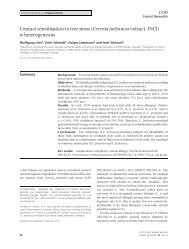703. INDIGOFERA HOWELLII Brian Schrire, Susyn Andrews and ...
703. INDIGOFERA HOWELLII Brian Schrire, Susyn Andrews and ...
703. INDIGOFERA HOWELLII Brian Schrire, Susyn Andrews and ...
Create successful ePaper yourself
Turn your PDF publications into a flip-book with our unique Google optimized e-Paper software.
‘Graceful, hardy, Chinese species. The most shrubby of<br />
all the Indigoferas, attaining about 5ft. The long arching<br />
branches bear up to 10 in. panicles of clear pink flowers<br />
.... 3/6 & 5/6.’ (Anon, 1928)<br />
According to John Hillier, this was the first descriptive catalogue<br />
that the firm of Hillier & Sons produced <strong>and</strong> the work was carried<br />
out by his father, 23 year-old Harold, later Sir Harold Hillier<br />
(1905–1985). This first description was somewhat padded out in<br />
Catalogue No. 1P (1937–1938):<br />
‘A very elegant Chinese species. The most shrubby of<br />
all the Indigoferas, attaining about 8ft. The long arching<br />
branches bear panicles as much as 10ins. long of clear pink<br />
flowers, which are conspicuous from June until the end of<br />
September ...2/6 to 5/6.’ (Anon, 1937)<br />
In the Supplementary List T.S. 20 (1938–1939), there is an interesting<br />
statement in the description of I. amblyantha.<br />
‘Very similar in every way to I. Potaninii <strong>and</strong> with all the<br />
good qualities of that valuable summer flowering species.<br />
Flowers shrimp pink..... 5/6.’ (Anon, 1938)<br />
Postwar catalogues have a slightly different description <strong>and</strong> it is quite<br />
possible that a different taxon was involved. In Catalogue No. 49 T<br />
(1952–1953), the description under I. potaninii wasasfollows:<br />
‘Graceful shrub up to 5ft high. Flowers clear pink in racemes<br />
4–5ins. long ...6/6 to 8/6.’ (Anon, 1952)<br />
Suddenly, the flower spikes have gone from 10 in. in length to<br />
4–5 in.! We know there was some confusion over the Hillier names<br />
as specimens of I. ambylantha had been labelled as I. potaninii in their<br />
arboretum. Between 1962 <strong>and</strong> 1977, the highest number of I. potaninii<br />
(whatever it was) sold per year was 86 plants <strong>and</strong> the lowest was 19<br />
(John Hillier, pers. comm.).<br />
Reginald Farrer (1880–1920) was a Yorkshireman with a passion<br />
for plants, an author, traveller <strong>and</strong> horticulturist. On April 24, 1919,<br />
while collecting with E.M.H. Cox in what was then known as Upper<br />
Burma, they came across a shrub growing in light brushwood in<br />
boulders by a stream at 1981 m, at the foot of Hpimaw Hill (Cox,<br />
1930). This was Farrer 866 (E!) <strong>and</strong> it had magenta-pink flowers. It was<br />
left as Indigofera sp. until described by W.G. Craib <strong>and</strong> W.W. Smith<br />
© The Board of Trustees of the Royal Botanic Gardens, Kew 2011. 77



